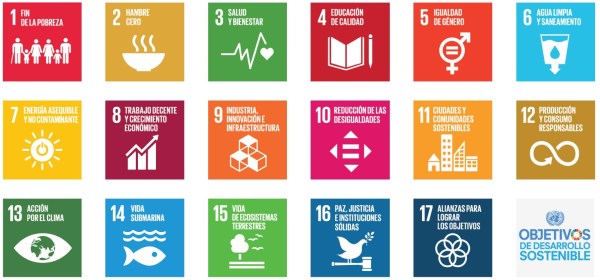In resolution A/RES/71/313 of July 2017, the United Nations General Assembly – one of the main bodies of the UN – approved the global indicator framework for the SDGs, developed by the Inter-Agency and Expert Group on Sustainable Development Goal Indicators.
The annex to the resolution, which specifies the indicators, explains that as far as possible the SDG indicators ‘should be disaggregated, where relevant, by income, gender, age, race, ethnicity, migration status, disability and geographic location’ among other things.
The main indicators for each of the 17 SDGs are as follows:
Ending poverty
Completely eradicate extreme poverty, defined as living on less than US$1.25 a day. The indicator to measure this goal is the proportion of the population below the international poverty line disaggregated, as mentioned above, by gender, age, employment status and rural/urban location.
Other indicators related to this first SDG are to measure GDP losses attributed to natural disasters or to know how many countries adopt strategies to reduce the risk of natural disasters.
Similarly, public social spending in favour of the poor, the proportion of public spending on essential services or subsidies for poverty reduction can also be measured.
Ending hunger
To end hunger and forms of malnutrition, the SDG indicators include the proportion of people who are undernourished or food insecure.
More specifically, the prevalence of stunting among under-fives is also considered an indicator.
Similarly, given the goal of doubling agricultural productivity and the incomes of small-scale food producers, the volume of production or the average income of small-scale producers can be measured. Similarly, the area on which sustainable and productive agriculture is practised can also be measured.
Ensuring healthy lives and promoting well-being
This objective encompasses different specific data, each of which has a specific indicator. Let us look at some of them.
To achieve a global maternal mortality ratio of less than 70 per 100,000 births, both the maternal mortality ratio, of course, and the proportion of births attended by skilled personnel must be measured.
Under-five mortality should also be measured, with a target of less than 25 per 1,000 live births, as well as the neonatal rate, with a target of less than 12 per 1,000 live births.
The range of targets in this objective is very broad and the indicators cover issues as varied as tobacco consumption in children under 15, how many people are immunised with vaccines, the incidence of different diseases such as tuberculosis, malaria or hepatitis B, and information on mortality due to suicide or traffic accidents.
Ensure inclusive and equitable education
Among other indicators, this SDG can be measured by the proportion of children with minimum levels of reading comprehension and mathematics at the end of secondary school, disaggregated by gender.
Similarly, one indicator is to know the completion rate of the different educational cycles.
Outside the area of children, the proportion by age group with basic literacy and numeracy skills is also considered as an indicator, as well as scholarship assistance.
In another area, the minimum qualifications required for teachers depending on the level of education should also be known.
Achieving gender equality
Given the generic goal of ending discrimination against girls and women, the proposed indicator is the existence of legal frameworks that promote equality and non-discrimination.
In more specific details, for example, to know how many women and girls have suffered physical, sexual or psychological violence or how many have undergone genital mutilation.
Also, in the area of care, it would be necessary to know what proportion of time is spent on unpaid care and/or domestic work.
In terms of women’s participation in public life, it is also proposed to measure the number of seats held by women in parliaments or local government, as well as the proportion of women in leadership positions.
Ensuring the availability and sustainable management of water
To achieve equitable and universal access to water, it is necessary to know what proportion of the population is using safely managed water services.
Among other issues, it is also important to have indicators with which to measure water stress or changes towards more efficient use of water resources.
From an administrative point of view, in order to improve international cooperation or the involvement of local communities in more efficient water management, it is necessary to know what official assistance is available from different administrations.
Ensuring access to affordable, reliable, sustainable and modern energy
The most obvious indicator for achieving the goal of energy access is how many people have access to energy, and how many people have a primary energy source in clean fuels and technologies.
With a view to increasing international cooperation that can facilitate research in this area, the indicator of progress is financial flows to developing countries that can support clean energy research and development.
Promoting sustained, inclusive and sustainable economic growth
The way to understand progress towards this goal is to measure the annual growth rate of real GDP per capita or per person employed.
In another area, and in order to eradicate forced labour, the proportion and number of children between the ages of 5 and 17 who are engaged in child labour must be known.
Knowing the frequency rate of occupational injuries (both fatal and non-fatal) or the level of compliance of different countries with labour rights are indicators to increase their protection and the promotion of safe environments.
Building resilient infrastructures
A first measurable indicator for developing reliable infrastructure is to know how many of the world’s rural population lives within 2 km of a road that is passable all year round.
Other indicators of progress towards SDG 9 include official international support for infrastructure, the number of researchers per million inhabitants and research and development expenditure as a proportion of GDP.
Related to the telecommunications sector, both the construction of networks and access to information and communications technology for universal and affordable access to the Internet are targets of this goal.
Reducing inequality within and between countries
Among other issues such as indicators of financial soundness or the proportion of people living below 50% of median income, another issue to consider in reducing inequality is how many people have felt discriminated against on grounds prohibited by international law.
Similarly, to apply the principle of special and differential treatment for developing countries under World Trade Organization agreements, the indicator is to know the proportion of tariff lines applied to imports from least developed countries.
Achieving inclusive, safe, resilient and sustainable cities.
Knowing how much of the urban population resides in marginal environments or access to public transportation are some of the indicators for moving towards inclusive, safe, resilient and sustainable urban environments.
It is also important to know how much is spent on preserving natural and cultural heritage, how much open space is devoted to the construction of new urban environments, and how many urban development plans take into account both demographic forecasts and resource needs.
Ensure sustainable consumption and production patterns.
Knowing how many countries include sustainable consumption and production as a priority, knowing global food loss rates or national recycling rates are indicators of progress towards this goal.
Similarly, it is also important to know how many companies publish reports on sustainability, the degree of global education in this area or other issues such as strategies or policies aimed at sustainable tourism.
Adopting measures against climate change and its effects.
Having information on the number of people affected by natural disasters per 100,000 inhabitants, how many countries adopt and implement risk reduction strategies or how many countries have incorporated climate change mitigation into their academic plans are indicators for making progress toward this goal.
On the other hand, it is also necessary to know how many least developed countries and/or small island developing states receive support of different types to mitigate and manage their relationship with climate change.
Conserving and sustainably using oceans and marine resources
To move towards the goal of reducing marine pollution, the density of floating plastic detritus must be measured.
In addition, knowing fish stocks at biologically sustainable levels is the indicator to be taken into account when regulating fishing operations.
Other indicators are to count how many countries are making progress through their respective legal frameworks in the ratification, acceptance and implementation of international law for the conservation and sustainable use of the seas and oceans and their resources.
Protect, restore and promote the sustainable use of terrestrial ecosystems.
To make progress towards this goal, there are numerous indicators, such as knowing how much of the planet’s total land area is forested, what proportion of terrestrial and freshwater biodiversity hotspots are protected, and how much degraded land there is.
It is also an indicator to stop poaching and trafficking of protected species to know how much of the fauna and flora specimens are illegally traded.
Promoting peaceful and inclusive societies
Numerous indicators can be taken into account in moving towards peaceful and inclusive societies, such as homicide victims, conflict-related deaths or victims of human trafficking per 100,000 people.
Issues as varied as the level of satisfaction with public services, the right to vote or quantifying levels of corruption are also indicators linked to this penultimate SDG.
Strengthen implementation and revitalize the Global Partnership for Sustainable Development
The targets of this SDG are financial, technological, trade or systemic issues such as institutional or policy coherence or data, monitoring and accountability.
Given these issues, the indicators can vary from knowing the income as a proportion of GDP in different countries, Internet access per 100 inhabitants, the weighted global average tariff or knowing whether the housing and population censuses of the different states are updated.
Telefónica and the measurement of the SDGs
In 2023, Telefónica had a total contribution to the SDGs quantifiable at around 113 billion euros, broken down into four blocks:
- 51.6 billion euros of economic contribution linked to SDGs 8, 9 and 16, considered as economic value directly or indirectly generated by activities and investments.
- 37.7 billion euros generated in communities by bringing connectivity and digitization to urban and rural areas, and another 18.3 billion euros of impact on the impact of inclusion, diversity and training. This heading includes SDGs 3, 4, 5, 8, 9, 10, 16 and 17.
- 5.5 billion euros of contribution to the environment with objectives 11, 12, 13, 14 and 15.









